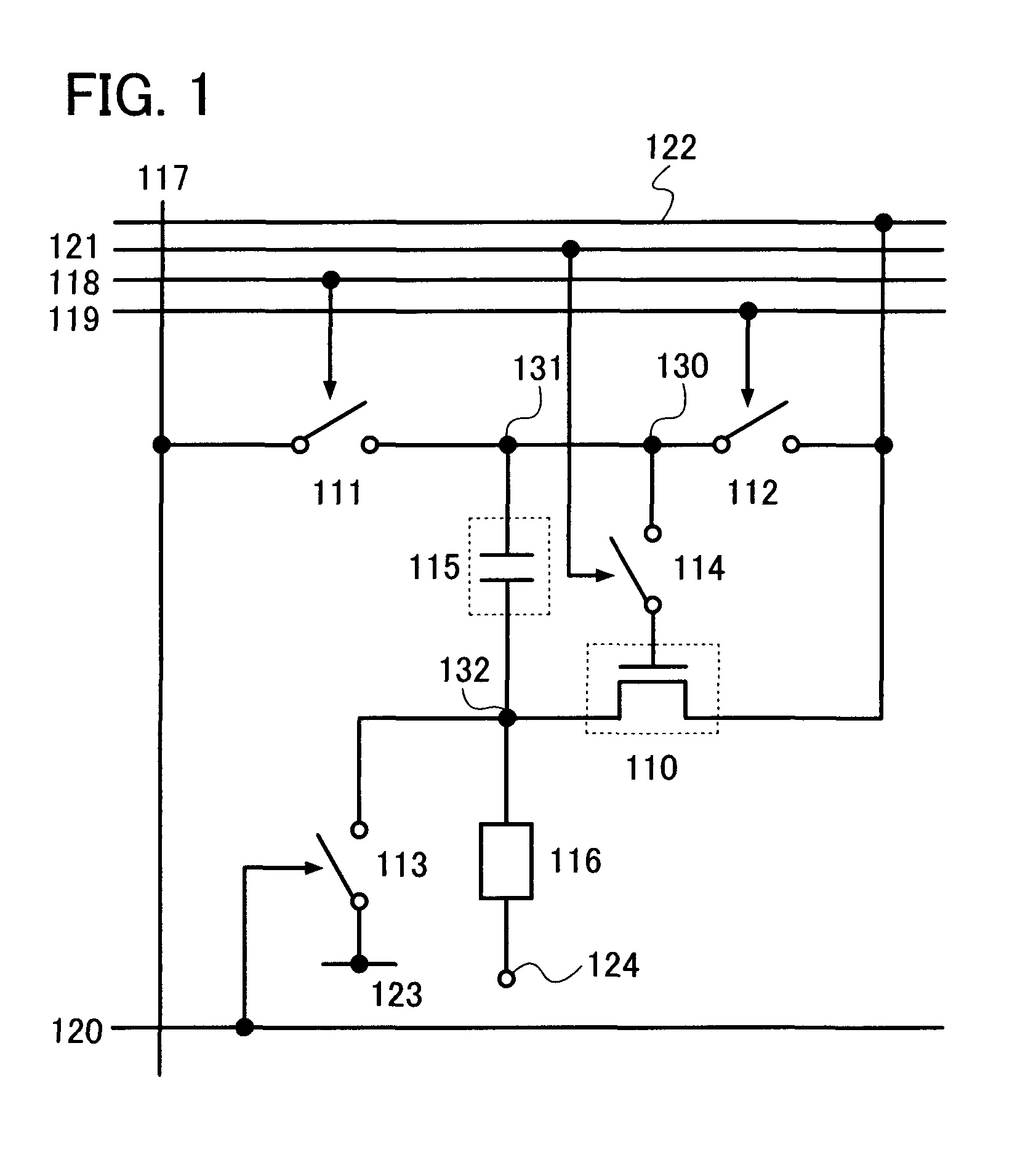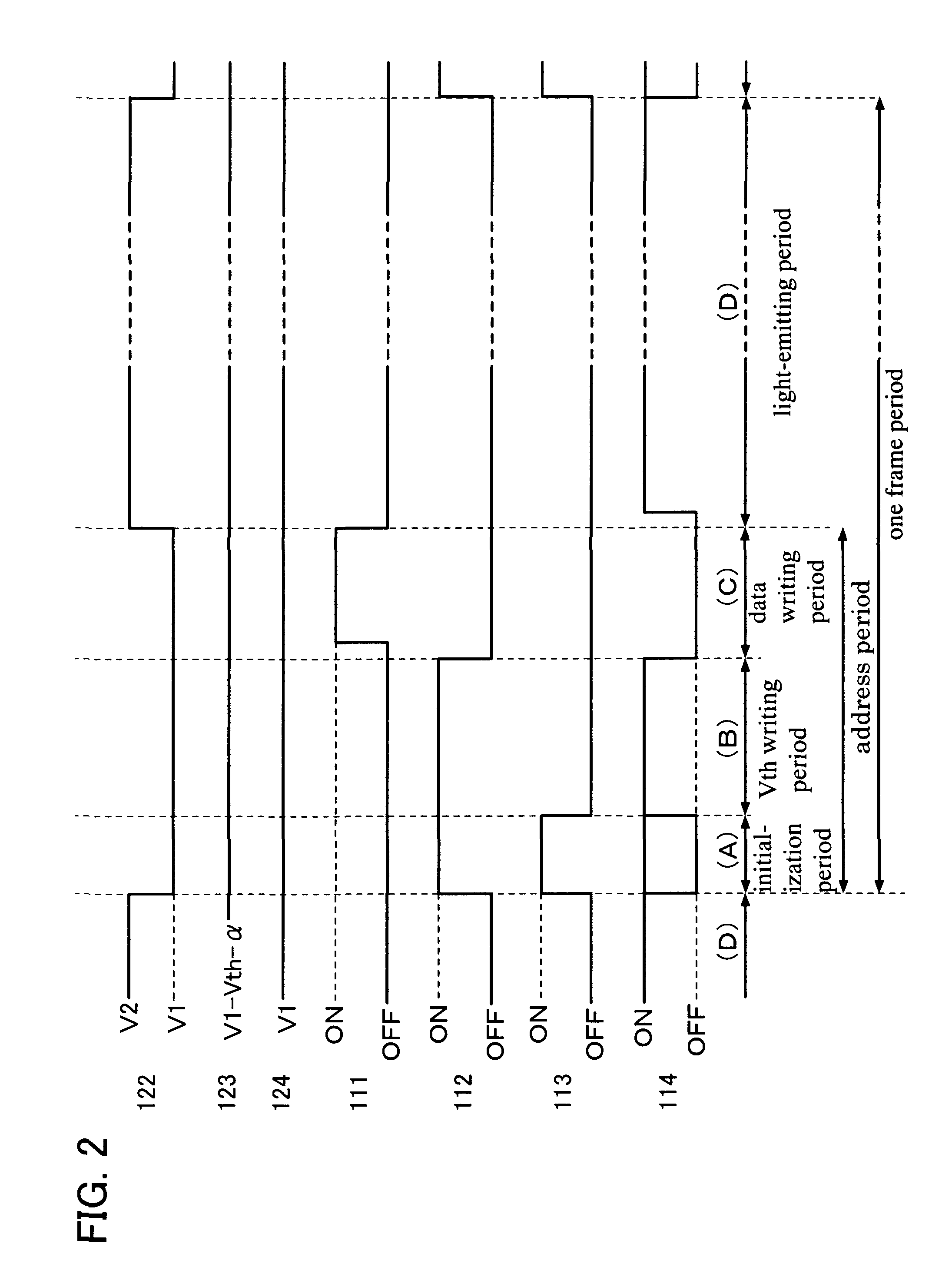Semiconductor device, display device, and electronic device
- Summary
- Abstract
- Description
- Claims
- Application Information
AI Technical Summary
Benefits of technology
Problems solved by technology
Method used
Image
Examples
embodiment mode 1
[0104]A basic configuration of a pixel of the invention is described with reference to FIG. 1. A pixel shown in FIG. 1 includes a transistor 110, a first switch 111, a second switch 112, a third switch 113, a fourth switch 114, a capacitor 115, and a light-emitting element 116. Note that the pixel is connected to a signal line 117, a first scan line 118, a second scan line 119, a third scan line 120, a fourth scan line 121, a power supply line 122, and a potential supply line 123. In this embodiment mode, the transistor 110 is an N-channel transistor, and is turned on when a gate-source voltage (Vgs) thereof exceeds the threshold voltage (Vth). In addition, an example is described in which an EL element in which a current is supplied from a pixel electrode 4811 to an opposite electrode 124 is used as the light-emitting element 116 as shown in FIG. 48. In that case, the pixel electrode 4811 of the light-emitting element 116 functions as an anode and the opposite electrode 124 thereof...
embodiment mode 2
[0168]In this embodiment mode, FIG. 11A shows a configuration of a pixel which is different from Embodiment Mode 1. Note that common reference numerals are used for portions which are similar to Embodiment Mode 1 and detailed description of the same portions or portions having similar functions is omitted.
[0169]A pixel shown in FIG. 11A includes the transistor 110, the first switch 111, the second switch 112, the fourth switch 114, a rectifying element 1113, the capacitor 115, and the light-emitting element 116. Note that the pixel is connected to the signal line 117, the first scan line 118, the second scan line 119, a third scan line 1120, the fourth scan line 121, and the power supply line 122. The pixel shown in FIG. 11A has a configuration in which the rectifying element 1113 is used as the third switch 113 in FIG. 3, and the second electrode of the capacitor 115, the first electrode of the transistor 110, and the pixel electrode of the light-emitting element 116 are connected ...
embodiment mode 3
[0175]In this embodiment mode, FIGS. 12 to 15 show configurations each a pixel which is different from Embodiment Modes 1 and 2. Note that although description is made by paying attention to one pixel in Embodiment Modes 1 and 2, the number of wirings can be reduced by sharing a wiring connected to each pixel among pixels. In this case, if normal operation can be performed, various wirings can be shared among the pixels. For example, a wiring can be shared with the next pixel and this embodiment mode shows one example of the method. Note that common reference numerals are used for portions which are similar to Embodiment Mode 1 and detailed description of the same portions or portions having similar functions is omitted.
[0176]A pixel 1200 shown in FIG. 12 includes the transistor 110, the first switch 111, the second switch 112, the third switch 113, the fourth switch 114, the capacitor 115, and the light-emitting element 116. Note that the pixel 1200 is connected to the signal line ...
PUM
 Login to View More
Login to View More Abstract
Description
Claims
Application Information
 Login to View More
Login to View More - R&D
- Intellectual Property
- Life Sciences
- Materials
- Tech Scout
- Unparalleled Data Quality
- Higher Quality Content
- 60% Fewer Hallucinations
Browse by: Latest US Patents, China's latest patents, Technical Efficacy Thesaurus, Application Domain, Technology Topic, Popular Technical Reports.
© 2025 PatSnap. All rights reserved.Legal|Privacy policy|Modern Slavery Act Transparency Statement|Sitemap|About US| Contact US: help@patsnap.com



